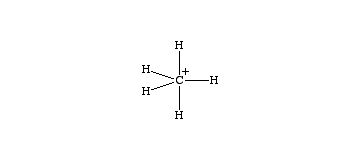 | ||
In chemistry, methanium is a positive ion with formula CH+
5, namely a molecule with one carbon atom bonded to five hydrogen atoms and bearing a +1 electric charge. It is a superacid and one of the onium ions, indeed the simplest carbonium ion.
Contents
Methanium can be produced in the laboratory as a rarefied gas or as a dilute species in superacids. It was prepared for the first time in 1950 and published in 1952 by Victor Talrose and his assistant Anna Konstantinovna Lyubimova. It occurs as an intermediate species in chemical reactions.
The methanium ion is named after methane (CH
4), by analogy with the derivation of ammonium ion (NH+
4) from ammonia (NH
3).
Structure
Methanium can be visualised as a CH3+ carbenium ion with a molecule of hydrogen interacting with the empty orbital in a 3-center-2-electron bond. The bonding electron pair in the H2 molecule is shared between the two hydrogen and one carbon atoms making up the 3-center-2-electron bond.
The two hydrogen atoms in the H2 molecule can continuously exchange positions with the three hydrogen atoms in the CH3+ ion (a conformation change called pseudorotation, specifically the Berry mechanism). The methanium ion is therefore considered a fluxional molecule. The energy barrier for the exchange is quite low and occurs even at very low temperatures.
Infrared spectroscopy has been used to obtain information about the different conformations of the methanium ion. The IR spectrum of plain methane has two C-H bands from symmetric and asymmetric stretching at around 3000 cm−1 and two bands around 1400 cm−1 from symmetrical and asymmetric bending vibrations. In the spectrum of CH5+ three asymmetric stretching vibrations are present around 2800 – 3000 cm−1, a rocking vibration at 1300 cm−1, and a bending vibration at 1100 1300 cm−1.
Preparation
Methanium can be prepared from methane by the action of very strong acids, such as antimony pentafluoride SbF
5 in hydrogen fluoride HF.
At about 2 Torr of pressure and ambient temperature, the methane ion CH+
4 will react with neutral methane to yield methanium and a methyl radical:
4 + CH
4 → CH+
5 + CH•
3
Stability and reactions
The cations obtained by reaction of methane with SbF
5 + HF are stabilized by interactions with the HF molecules.
At low pressures (around 1 mmHg) and ambient temperatures, methanium is unreactive towards neutral methane.
